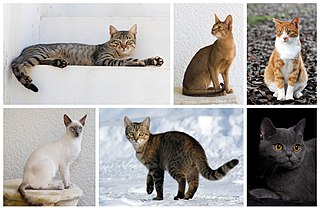
The cat is a domestic species of small carnivorous mammal. It is the only domesticated species in the family Felidae and is often referred to as the domestic cat to distinguish it from the wild members of the family. A cat can either be a house cat, a farm cat or a feral cat; the latter ranges freely and avoids human contact. Domestic cats are valued by humans for companionship and their ability to kill rodents. About 60 cat breeds are recognized by various cat registries.

Felis is a genus of small and medium-sized cat species native to most of Africa and south of 60° latitude in Europe and Asia to Indochina. The genus includes the domestic cat. The smallest Felis species is the black-footed cat with a head and body length from 38 to 42 cm. The largest is the jungle cat with a head and body length from 62 to 76 cm.

The wildcat is a species complex comprising two small wild cat species: the European wildcat and the African wildcat. The European wildcat inhabits forests in Europe and the Caucasus, while the African wildcat inhabits semi-arid landscapes and steppes in Africa, the Arabian Peninsula, Central Asia, into western India and western China. The wildcat species differ in fur pattern, tail, and size: the European wildcat has long fur and a bushy tail with a rounded tip; the smaller African wildcat is more faintly striped, has short sandy-gray fur and a tapering tail; the Asiatic wildcat is spotted.

Egyptian Maus are a small to medium-sized short-haired cat breed. They are one of the few naturally spotted breeds of domesticated cat. The spots of the Mau occur on only the tips of the hairs of its coat. It is considered a rare breed.
Purebreds are "cultivated varieties" of an animal species achieved through the process of selective breeding. When the lineage of a purebred animal is recorded, that animal is said to be "pedigreed". Purebreds breed true-to-type which means the progeny of like-to-like purebred parents will carry the same phenotype, or observable characteristics of the parents. A group of purebreds is called a pure-breeding line or strain.

A feral cat or a stray cat is an unowned domestic cat that lives outdoors and avoids human contact: it does not allow itself to be handled or touched, and usually remains hidden from humans. Feral cats may breed over dozens of generations and become an aggressive local apex predator in urban, savannah and bushland environments. Some feral cats may become more comfortable with people who regularly feed them, but even with long-term attempts at socialization, they usually remain aloof and are most active after dusk.

The domestication of animals is the mutual relationship between animals and the humans who have influence on their care and reproduction.
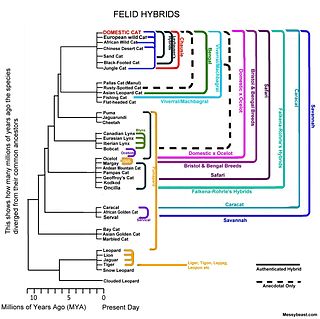
A felid hybrid is any of a number of hybrid between various species of the cat family, Felidae. This article deals with hybrids between the species of the subfamily Felinae.

The origin of the domestic dog includes the dog's genetic divergence from the wolf, its domestication, and the emergence of the first dogs. Genetic studies show that all ancient and modern dogs share a common ancestry and descended from an ancient, now-extinct wolf population – or closely related wolf populations – which was distinct from the modern wolf lineage. The dog's similarity to the extant grey wolf is the result of substantial dog-into-wolf gene flow, with the modern grey wolf being the dog's nearest living relative. An extinct Late Pleistocene wolf may have been the ancestor of the dog.
The Cretan wildcat is a member of the genus Felis that inhabits the Greek island of Crete. Its taxonomic status is unclear at present, as some biologists consider it probably introduced, or a European wildcat, or a hybrid between European wildcat and domestic cat . Felis silvestris cretensis was proposed as scientific name for the Cretan wildcat in 1953 by Theodor Haltenorth. He described two cat skins that were purchased in a bazaar in Chania and resembled a skin of an African wildcat, but with a bushy tail like a European wildcat. In the 1980s, Colin Groves measured and assessed zoological specimens of cats that originated in the Mediterranean islands. He concluded that the two cat skins from Crete differed from true wildcat specimens and therefore considered them feral cats.

The European wildcat is a small wildcat species native to continental Europe, Scotland, Turkey and the Caucasus. It inhabits forests from the Iberian Peninsula, Italy, Central and Eastern Europe to the Caucasus. Its fur is brownish to grey with stripes on the forehead and on the sides and has a bushy tail with a black tip. It reaches a head-to-body length of up to 65 cm (26 in) with a 34.5 cm long tail, and weighs up to 7.5 kg (17 lb).

A tabby is any domestic cat with a distinctive 'M'-shaped marking on its forehead; stripes by its eyes and across its cheeks, along its back, and around its legs and tail; and, characteristic striped, dotted, lined, flecked, banded, or swirled patterns on the body—neck, shoulders, sides, flanks, chest, and abdomen. "Tabby" is not a breed of cat but a coat type seen in almost all genetic lines of domestic cats, regardless of status.

The African wildcat is a small wildcat species native to Africa, West and Central Asia up to Rajasthan in India and Xinjiang in China. The IUCN Red List status Least Concern is attributed to the species Felis silvestris, which at the time of assessment also included the African wildcat as a subspecies.

Cat genetics describes the study of inheritance as it occurs in domestic cats. In feline husbandry it can predict established traits (phenotypes) of the offspring of particular crosses. In medical genetics, cat models are occasionally used to discover the function of homologous human disease genes.
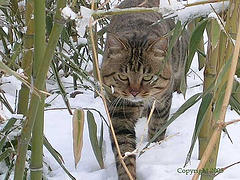
The Dragon Li is a recently established Chinese breed of domestic cat. It was developed from a common landrace of cats in China, known as 貍花貓, Pinyin: líhuā māo, literally 'fox flower cat' ; the native cats are featured in some Chinese folklore stories. The derived standardized breed is recognized by China's Cat Aficionado Association (CAA) the US-based, international Cat Fanciers' Association (CFA).
The history of horse domestication has been subject to much debate, with various competing hypotheses over time about how domestication of the horse occurred. The main point of contention was whether the domestication of the horse occurred once in a single domestication event, or that the horse was domesticated independently multiple times. The debate was resolved at the beginning of the 21st century using DNA evidence that favored a mixed model in which domestication of the stallion most likely occurred only once, while wild mares of various regions were included in local domesticated herds.
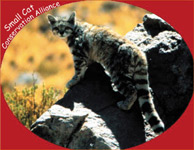
The Small Cat Conservation Alliance (SCCA) was founded in 1996, to address the conservation needs of small wild cats and their habitat worldwide. Small Cat Conservation Alliance seeks out local scientists and volunteers that are working to protect small cats in remote regions worldwide. They collect data that can be used to seek endangered species classification. SCCA operates in Kalimantan (Borneo), Sumatra, Chile, and China; and works with partners in Argentina, Bolivia, Brazil, Cambodia, India, Sarawak, Suriname and Vietnam. The Small Cat Conservation is also partnered with the Wildlife Conservation Network.
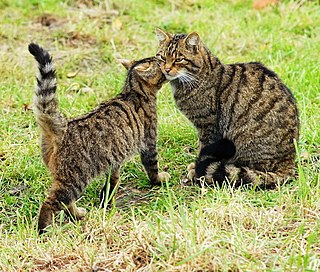
The Scottish wildcat is a European wildcat population in Scotland. It is estimated to comprise between 1,000 and 4,000 individuals, of which about 400 cats are thought to meet the morphological and genetic criteria of a wildcat. The Scottish wildcat was once widely distributed across Great Britain, but the population has declined drastically since the turn of the 20th century due to habitat loss and persecution. It is now limited to northern and eastern Scotland. It is listed as Critically Endangered in the United Kingdom, threatened by both hybridization with domestic cats as well as more immediate, large-scale threats to their remaining habitat due to increased human demand for natural resources. Camera-trapping surveys carried out in the Scottish Highlands between 2010 and 2013 revealed that wildcats live foremost in mixed woodland, whereas feral and domestic cats were photographed mostly in grasslands.

The Southern African wildcat is an African wildcat subspecies native to Southern and Eastern Africa. In 2007, it was tentatively recognised as a distinct subspecies on the basis of genetic analysis. Morphological evidence indicates that the split between the African wildcat subspecies in Africa occurred in the area of Tanzania and Mozambique.
Highland cat may refer to:















